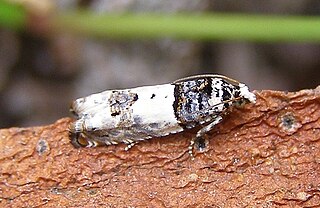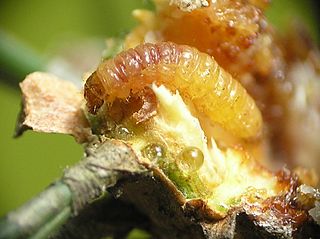Retinia is a genus of moths belonging to the subfamily Olethreutinae of the family Tortricidae.

Gravitarmata margarotana, the pine cone tortrix or pine twig moth, is a moth of the family Tortricidae. In Europe, it is found from England to Austria and Poland, east to the Baltic region to Russia, China, Korea and Japan.

Gypsonoma sociana is a moth of the family Tortricidae. It is found from Europe to Russia, China and Japan.

Retinia resinella, the pine resin-gall moth, is a moth of the family Tortricidae.

Epinotia nanana, the European spruce needleminer, is a moth of the family Tortricidae. It is found from northern and central Europe to Russia and Mongolia.

Retinia cristata is a moth of the family Tortricidae. It is found in Japan, Korea, northern and central China, Taiwan and Thailand.
The Eucosmini are a tribe of tortrix moths.

Ecdytolopha insiticiana, the locust twig borer is a moth of the family Tortricidae. It is found in North America, including Pennsylvania, Iowa, West Virginia, Arkansas, Massachusetts, New York and Ontario.

Crocidosema lantana, the lantana flower-cluster moth or lantana tortricid moth, is a moth of the family Tortricidae. It was first described by August Busck in 1910. It is native to Mexico and the southern United States, but was introduced to Hawaii in 1902, Australia in 1914 and the Caroline Islands in 1948 and 1949 to aid in the control of Lantana weeds. It has also been recorded from Yunnan, China and in Sri Lanka.

Grapholita molesta, the oriental fruit moth or peach moth, is a moth of the family Tortricidae. It is native to China, but was introduced to Japan and North America and is now also found throughout of Europe, Asia and South America and in Hawaii, Morocco, Mauritius, South Africa, Australia and New Zealand

Proteoteras willingana, the eastern boxelder twig borer moth, is a moth of the family Tortricidae. It is found in southern Canada and the eastern United States, west through the Great Plains.

Hystrichophora taleana, the indigobush twig borer, is a moth of the family Tortricidae. It is known from the United States where it was found in Washington and Sharkey counties in Mississippi and Chico County in southeastern Arkansas.

Retinia albicapitana, the northern pitch twig moth, is a moth of the family Tortricidae. In Canada it is found from Nova Scotia to British Columbia and north probably into the southern parts of the Northwest Territories. In the United States, it extends as far south as Montana and the Great Lakes states.

Retinia arizonensis, the pinyon pitch nodule moth, is a species of moth of the family Tortricidae. It is found in North America.
Retinia coeruleostriana is a species of moth of the family Tortricidae. It is found in China, Japan and Russia.
Retinia pseudotsugaicola is a species of moth of the family Tortricidae. It is found in Yunnan, China.
Retinia teleopa is a species of moth of the family Tortricidae. It is found in China.
Retinia impropria is a species of moth of the family Tortricidae. It is found in China, Japan, Mongolia and Russia.
Cydia servillana is a moth of the family Tortricidae which forms galls on the young shoots of willow. It was first described by Philogène Auguste Joseph Duponchel in 1836.
Twig borer refers to a number of species of beetles and moths that chew holes into small branches of trees and shrubs. Many of these insects are agricultural pests. Animals that are called twig borers include:














